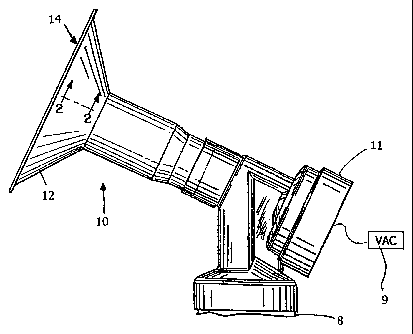Some of the information on this Web page has been provided by external sources. The Government of Canada is not responsible for the accuracy, reliability or currency of the information supplied by external sources. Users wishing to rely upon this information should consult directly with the source of the information. Content provided by external sources is not subject to official languages, privacy and accessibility requirements.
Any discrepancies in the text and image of the Claims and Abstract are due to differing posting times. Text of the Claims and Abstract are posted:
| (12) Patent: | (11) CA 2475842 |
|---|---|
| (54) English Title: | LUBRICATED BREASTSHIELD |
| (54) French Title: | PROTEGE-SEIN LUBRIFIE |
| Status: | Expired and beyond the Period of Reversal |
| (51) International Patent Classification (IPC): |
|
|---|---|
| (72) Inventors : |
|
| (73) Owners : |
|
| (71) Applicants : |
|
| (74) Agent: | MARKS & CLERK |
| (74) Associate agent: | |
| (45) Issued: | 2009-06-09 |
| (86) PCT Filing Date: | 2002-02-11 |
| (87) Open to Public Inspection: | 2003-08-21 |
| Examination requested: | 2007-01-25 |
| Availability of licence: | N/A |
| Dedicated to the Public: | N/A |
| (25) Language of filing: | English |
| Patent Cooperation Treaty (PCT): | Yes |
|---|---|
| (86) PCT Filing Number: | PCT/US2002/003896 |
| (87) International Publication Number: | WO 2003068291 |
| (85) National Entry: | 2004-08-11 |
| (30) Application Priority Data: | None |
|---|
An improved breastshield (14) for a breastpump (10) having a coating of a
lubricating (16) material formed integral with the interior of the breast-
receiving cone (12).
L'invention concerne un protège-sein amélioré (14) destiné à un tire-lait (10) et pourvu d'une couche de lubrifiant (16) incorporée à l'intérieur de la téterelle (12).
Note: Claims are shown in the official language in which they were submitted.
Note: Descriptions are shown in the official language in which they were submitted.

2024-08-01:As part of the Next Generation Patents (NGP) transition, the Canadian Patents Database (CPD) now contains a more detailed Event History, which replicates the Event Log of our new back-office solution.
Please note that "Inactive:" events refers to events no longer in use in our new back-office solution.
For a clearer understanding of the status of the application/patent presented on this page, the site Disclaimer , as well as the definitions for Patent , Event History , Maintenance Fee and Payment History should be consulted.
| Description | Date |
|---|---|
| Time Limit for Reversal Expired | 2013-02-11 |
| Letter Sent | 2012-02-13 |
| Grant by Issuance | 2009-06-09 |
| Inactive: Cover page published | 2009-06-08 |
| Notice of Allowance is Issued | 2009-04-02 |
| Inactive: Office letter | 2009-04-02 |
| Inactive: Approved for allowance (AFA) | 2009-03-31 |
| Letter Sent | 2009-03-18 |
| Reinstatement Request Received | 2009-02-19 |
| Pre-grant | 2009-02-19 |
| Withdraw from Allowance | 2009-02-19 |
| Final Fee Paid and Application Reinstated | 2009-02-19 |
| Deemed Abandoned - Conditions for Grant Determined Not Compliant | 2008-11-07 |
| Notice of Allowance is Issued | 2008-05-07 |
| Notice of Allowance is Issued | 2008-05-07 |
| Letter Sent | 2008-05-07 |
| Inactive: Approved for allowance (AFA) | 2008-02-04 |
| Amendment Received - Voluntary Amendment | 2007-11-20 |
| Letter Sent | 2007-02-20 |
| Request for Examination Requirements Determined Compliant | 2007-01-25 |
| All Requirements for Examination Determined Compliant | 2007-01-25 |
| Request for Examination Received | 2007-01-25 |
| Letter Sent | 2004-12-22 |
| Inactive: Single transfer | 2004-11-15 |
| Inactive: Cover page published | 2004-10-12 |
| Inactive: Notice - National entry - No RFE | 2004-10-08 |
| Inactive: Courtesy letter - Evidence | 2004-10-08 |
| Application Received - PCT | 2004-09-08 |
| National Entry Requirements Determined Compliant | 2004-08-11 |
| Application Published (Open to Public Inspection) | 2003-08-21 |
| Abandonment Date | Reason | Reinstatement Date |
|---|---|---|
| 2009-02-19 | ||
| 2008-11-07 |
The last payment was received on 2009-02-10
Note : If the full payment has not been received on or before the date indicated, a further fee may be required which may be one of the following
Please refer to the CIPO Patent Fees web page to see all current fee amounts.
| Fee Type | Anniversary Year | Due Date | Paid Date |
|---|---|---|---|
| Registration of a document | 2004-08-11 | ||
| MF (application, 3rd anniv.) - standard | 03 | 2005-02-11 | 2004-08-11 |
| MF (application, 2nd anniv.) - standard | 02 | 2004-02-11 | 2004-08-11 |
| Basic national fee - standard | 2004-08-11 | ||
| MF (application, 4th anniv.) - standard | 04 | 2006-02-13 | 2006-01-25 |
| MF (application, 5th anniv.) - standard | 05 | 2007-02-12 | 2007-01-25 |
| Request for examination - standard | 2007-01-25 | ||
| MF (application, 6th anniv.) - standard | 06 | 2008-02-11 | 2008-01-25 |
| MF (application, 7th anniv.) - standard | 07 | 2009-02-11 | 2009-02-10 |
| Final fee - standard | 2009-02-19 | ||
| Reinstatement | 2009-02-19 | ||
| MF (patent, 8th anniv.) - standard | 2010-02-11 | 2010-01-18 | |
| MF (patent, 9th anniv.) - standard | 2011-02-11 | 2011-01-17 |
Note: Records showing the ownership history in alphabetical order.
| Current Owners on Record |
|---|
| MEDELA HOLDING AG |
| Past Owners on Record |
|---|
| BRIAN H. SILVER |